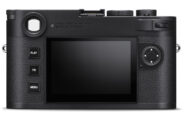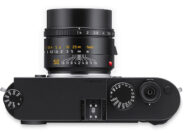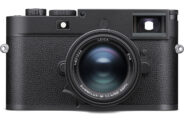Announced
Production status
Order No.
System
Leica M system cameras
- Leica M (Typ 240)
- Leica M (Typ 262)
- Leica M Monochrom
- Leica M Monochrom (Typ 246)
- Leica M-A (Typ 127)
- Leica M-D (Typ 262)
- Leica M-E (Typ 220)
- Leica M-E (Typ 240)
- Leica M-P (Typ 240)
- Leica M1
- Leica M10
- Leica M10 Monochrom
- Leica M10-D
- Leica M10-P
- Leica M10-R
- Leica M11
- Leica M11 Monochrom
- Leica M11-P
- Leica M2
- Leica M3
- Leica M4
- Leica M4-2
- Leica M4-P
- Leica M5
- Leica M6
- Leica M6 (Typ 2248)
- Leica M6 Panda
- Leica M6 Titanium
- Leica M6 TTL
- Leica M6J
- Leica M7
- Leica M8
- Leica M8.2
- Leica M9
- Leica M9-P
- Leica MD
- Leica MD-2
- Leica MDa
- Leica MP
- Leica MP Original
Leica M11 Monochrom
35mm MF digital rangefinder camera
Specification
| Format: | |
| 35mm full frame | |
Imaging sensor: | 35.8 × 23.9mm CMOS sensor |
Resolution: | 9528 × 6328 - 60 MP |
Sensor-shift image stabilization: | - |
| Leica M [27.8mm] | |
| Shutter: | |
Type: | Focal-plane |
Model: | Electronically controlled |
Speeds: | 3600 - 1/6000 + B |
| Exposure: | |
Exposure metering: | Through-the-lens (TTL), open-aperture |
Exposure modes: | Aperture-priority Auto |
| Manual | |
| Rangefinder and Viewfinder: | |
Rangefinder: | Built-in, combined with viewfinder |
Viewfinder: | Built-in, combined with rangefinder |
Finder magnification: | 0.73x |
Bright-line frames: | 35mm & 135mm, 28mm & 90mm, 50mm & 75mm |
Parallax compensation: | Yes |
| Physical characteristics: | |
Weight: | 542g |
Dimensions: | 138.8x80.3x38.5mm |
| Accessories: | |
Body cap: | 14195 |
| 14397 |
Manufacturer description #1
Teaneck, NJ April 13th 2023. Leica Camera, a brand that has challenged the status quo in pursuit of chasing light for authentic visual stories, announces the launch of the Leica M11 Monochrom, demonstrating the brand’s commitment to exceptional black & white photography. Featuring a dedicated monochrome multi-resolution full-frame BSI sensor, this camera is a masterstroke in engineering, capturing images solely through the interplay of light and shadow. By focusing on these fundamental elements, Leica empowers visual storytellers to create images that engage the viewer's imagination and creative prowess through a newly designed sensor which sees only variations in luminosity.
Leica's commitment to innovation is further underscored by its previous forays into minimalist design, such as releasing a digital camera without an LCD screen, and introducing the first camera featuring a monochrome sensor in 2012, the Leica M Monochrom. These unconventional decisions exemplify the brand's unyielding dedication to providing photographers with tools that inspire creativity, while eliminating distractions.
The Leica M11 Monochrom is more than just a camera – it is an artistic instrument crafted with unparalleled precision. The all-metal body, high-quality aluminum top plate, sapphire glass display, leatherette covering, and scratch-resistant black finish contribute to the camera's timeless appeal. Details such as the omission of the Leica logo and dark chrome-plated coating of the optical viewfinder accentuate the camera's understated, iconic design.
The technical advancements of the Leica M11 Monochrom deliver raw files in the DNG format or JPEGs with a resolution of either 60, 36 or 18 megapixels. In combination with the expanded ISO range of 125 to 200,000, the camera unlocks creative freedom beyond the rise and fall of the sun. As a result, creators are able to capture images with an unprecedented rendition of even the finest details, an exceptionally natural-looking definition even in difficult light conditions and an extremely low noise even in the high ISO range.
Additionally, the internal memory has been extended to 256 GB. This expansion not only increases the total number of images that can be recorded in combination with the photographer’s own memory cards, but also provides back up opportunities with larger memory card sizes. Via Bluetooth or the USB-C port, pictures can be quickly and easily transferred to the Leica FOTOS app and processed further from there. The Leica M11 Monochrom is a certified Apple “Made for iPhone and iPad” accessory and offers unique options with the included Leica FOTOS cable.
The Leica M11 Monochrom is built on a tradition of excellence, from a legacy of exquisite craftsmanship, innovation, and iconic design to the ethos of the Leica M family: “Made in Germany” with a focus on the essentials: Das Wesentliche.
Manufacturer description #2
Creating images with only light and shadow
We’ve been developing and manufacturing rangefinder cameras for almost 70 years, and monochrome sensors for 11 years. The Leica M11 Monochrom continues the success story of our monochrome series, now in its eleventh year, with the 4th generation of Leica M cameras completely dedicated to black and white photography.
As an intuitive precision tool, the M11 Monochrom makes it possible to capture truly exceptional black-and-white images. It also serves as a source of inspiration, opening up a world of freedom and flexibility to all photographers who are completely dedicated to black and white. So they can achieve and perfect their visions, composing pictures with nothing but light and shadow.
Focused on the essential
Even today, black and white photography remains a highly regarded artistic medium. A masterpiece of craftsmanship, the Leica M11 Monochrom is the perfect instrument for achieving your artistic potential to the fullest. You’ll be able to shoot black-and-white images that depict the finest details with outstandingly natural sharpness. This is ensured by the BSI CMOS sensor which has been specially developed for the Leica M11 generation – without colour filters and with extremely high sensitivity. It also gives you the freedom to choose between 60, 36 and 18 megapixel resolution at any time, as a RAW file in DNG format or as a JPEG. And every shot will have that unmistakable M11 Monochrom character – and your own personal signature.
A complete world of light and shadow
While the history of the Leica M Monochrom casts long shadows, the Leica M11 Monochrom brings details to light like no camera before. Its BSI CMOS sensor is a true declaration of love for black and white photography. Thanks to the Triple Resolution Technology with a resolution of up to 60 MP, double-layer absorption filter glass and the deliberate omission of color filters, it raises black-and-white image quality to an unprecedented level.
The M11 Monochrome reveals new dimensions in the interplay of light and shadow for incomparable images. Even in difficult lighting conditions, you can attain a breath-taking dynamic range and unprecedented level of fine detail. This is made possible by the extreme ISO range from 125 to 200,000 – so even with high sensitivity, you can take pictures with extremely low image noise.
Iconic. Uncompromising. Minimalist.
Like all M cameras, the M11 Monochrom has a timeless aesthetic and extremely discreet design. Its minimalist design philosophy aims to attract as little attention as possible when shooting, for instance, the deliberate omission of the red Leica logo and the dark chrome coating of the optical viewfinder. This allows you to blend in inconspicuously into the action, enabling it to capture authentic images that are anything but inconspicuous.
Legendary Leica quality
The Leica M11 Monochrom fits perfectly in your hand. Not too heavy, yet not too light. The camera is manufactured with the highest quality standards, such as its all-metal body and top plate made of high-quality aluminium, the sapphire glass display and the solid leather finish. Attributes such as durability, robustness and reliability are not just words, but something you can really see and feel in the Leica M11 Monochrom.
High-quality materials, precisely manufactured by hand in the Leica factory, combine to create a camera that is second to none. A camera of legendary quality "Made in Germany“.
Optimal workflow – even on the go
With 256 GB of internal memory and convenient connectivity to the Leica FOTOS app, the Leica M11 Monochrom offers an optimal mobile workflow. Images can be quickly transferred to the app and further processed via Bluetooth or USB-C connection. In addition, the camera can be controlled via the app and the photos assessed directly on your mobile device with a tethered preview. As a certified Apple "Made for iPhone® and iPad®" accessory, the Leica M11 Monochrom opens up unique possibilities in conjunction with the included Leica FOTOS cable.
Perfect interaction
A camera can only perform up to the limits of its lens. That's why, for over 150 years, we’ve been developing and manufacturing extraordinarily high-performance lenses that do justice to the M11 Monochrom and its high-resolution image sensor. As a result, the camera and each legendary M lens interact as one to produce images of unprecedented quality.






